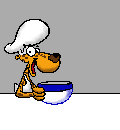About These Recipes
(Chapter 16 of the book)
- Kid-Friendlier Recipes
- Assumptions about Ingredients
- Sidebars:
- Cooking with Fahrenheit—a few degrees of separation
- Eating wine and spirits
- No flame, no fire recipes
- Baking sheet, cookie sheet, and jelly roll pan
What do you get when you cross an avocado, a duck, and a food processor?
Quackamole.
The recipes in this book are designed to coach you through cooking. They may look long, but that's because each step is clearly identified, so that novice cooks can easily follow along. Despite their terrific taste, these mouth-watering recipes are simple and flexible enough for parents and kids to make together, without fear of failure or frustration. Most recipes take less than 30 minutes of hands-on preparation time, although some require longer cooking time. Use these recipes to spur your own creative juices—with a bit of practice, you can devise your own original recipes for the whole family to enjoy.
Cooking with Fahrenheit—a few degrees of separation

The recipes in this book use the Fahrenheit temperature scale, in which water freezes at 32 degrees and boils at 212 degrees. The United States uses the Fahrenheit scale, but some other countries use the Celsius (or Centigrade) scale, in which water freezes at 0 degrees degrees and boils at 100 degrees.
To convert Fahrenheit temperatures to Celsius, subtract 32 from the Fahrenheit degree, multiply by 5, and divide by 9. Give it a try: What temperature on the Celsius scale is equivalent to 350 degrees Fahrenheit? Give up? Check the answer here.
Before You Begin

As you prepare the recipes in this part, keep the following in mind:
These recipes are intended to involve all family members. For safety's sake, always make them with an adult around.
All of these recipes are intentionally simple to make, and every recipe has steps in it that can include kids from preschool on up. Use children's ages and abilities to determine exactly what tasks they can do. Parents, encourage kids to join in, while you supervise and assist, as needed.
These recipes are somewhat flexible, allowing for a certain margin of error or inaccuracy. Don't panic if you think you've messed up a recipe—it will likely taste fine, and if not, throw it out and try again.
Parents and kids alike should follow the ten kitchen commandments in the Cheat Sheet at the front of this book and safety tips in Chapter 8.
Chapters 8 through 15 describe basic cooking techniques and terms. Refer to them whenever you're unsure about a term or technique.
Pay attention to the recipe's headnotes (that's the introduction at the beginning of the recipe) and to the sidebars (the blue boxes of text) in the recipe chapters. You can discover cooking tips, food tidbits, and information about other cultures, which opens up all sorts of windows to the world through cooking.
Eating wine and spirits

Is it safe for kids to cook with wine or eat meals made with more potent alcoholic beverages, known as spirits? Made properly, foods cooked with alcohol are perfectly safe to serve youngsters. The dish should be cooked long enough, usually several minutes, for the alcohol itself to evaporate, leaving only harmless trace residues and the concentrated flavor of the wine or beverage used. Cooking with wine, beer, sherry, and spirits can greatly enhance the taste of some dishes, acting as a flavor conductor to heighten the taste of all the ingredients.
Certain religions or lifestyles suggest that people not use alcohol, though, so some families never cook with it. If you think your dinner guests may abstain from alcohol in any form, even in cooking, ask them before planning the meal. If for any reason you prefer not to cook with alcohol, you can usually substitute nonalcoholic wine, broth, water, or grape juice with a splash of lemon juice.
Beer and wine have less alcohol and won't ignite, but stronger spirits will actually burn if touched by a flame or heated sufficiently. To keep alcohol from accidentally igniting—as some fancy restaurants intentionally do by pouring brandy on a dish and then setting it aflame—turn off the heat while adding the alcohol, then turn it on again to cook the alcohol off. And never buy so-called "cooking wine"—it's made from inferior wine and usually laced with salt or other additives. Only if an alcoholic beverage is suitable for an adult to drink and enjoy is it suitable for cooking.
Chapters 8 through 15 describe basic cooking techniques and terms. Refer to them whenever you're unsure about a term or technique.
Pay attention to the recipe's headnotes (that's the introduction at the beginning of the recipe) and to the sidebars (the blue boxes of text) in the recipe chapters. You can discover cooking tips, food tidbits, and information about other cultures, which opens up all sorts of windows to the world through cooking.

Search this site:
Recipes
About These Recipes
Breakfasts, Brown-Bags & Breads
Brown-Bag Barcelona Chicken
Buttermilk Basil Dressing
Chinese "Barbecued" Pork
Cool-as-a-Cucumber Dressing
(A No-Flame, No-Fire Recipe)
Cranberry-Cinnamon
Poached Pears
Green Onion French Bread
Happy, Dappy, Flappy Jacks
Irma's Spiced Nuts-to-You
Mango-Cheese Quesadilla
Mexican Fiesta Taco
or Burrito Mix
Orange-Scented Couscous
Tips
Ten Items for Your
Kid's Cookware Kit
Kid-Friendlier Recipes
About Ingredients
Cooking with Fahrenheit
Eating wine and spirits
Cookie sheet & jelly roll pan
More Cooking Tips
General Cooking Tips
Food at Hand: Eating
Finger Foods
Alexandria's Top Ten Cooking
Tips for Other Kids
Ten Kids-in-the-Kitchen
Commandments


